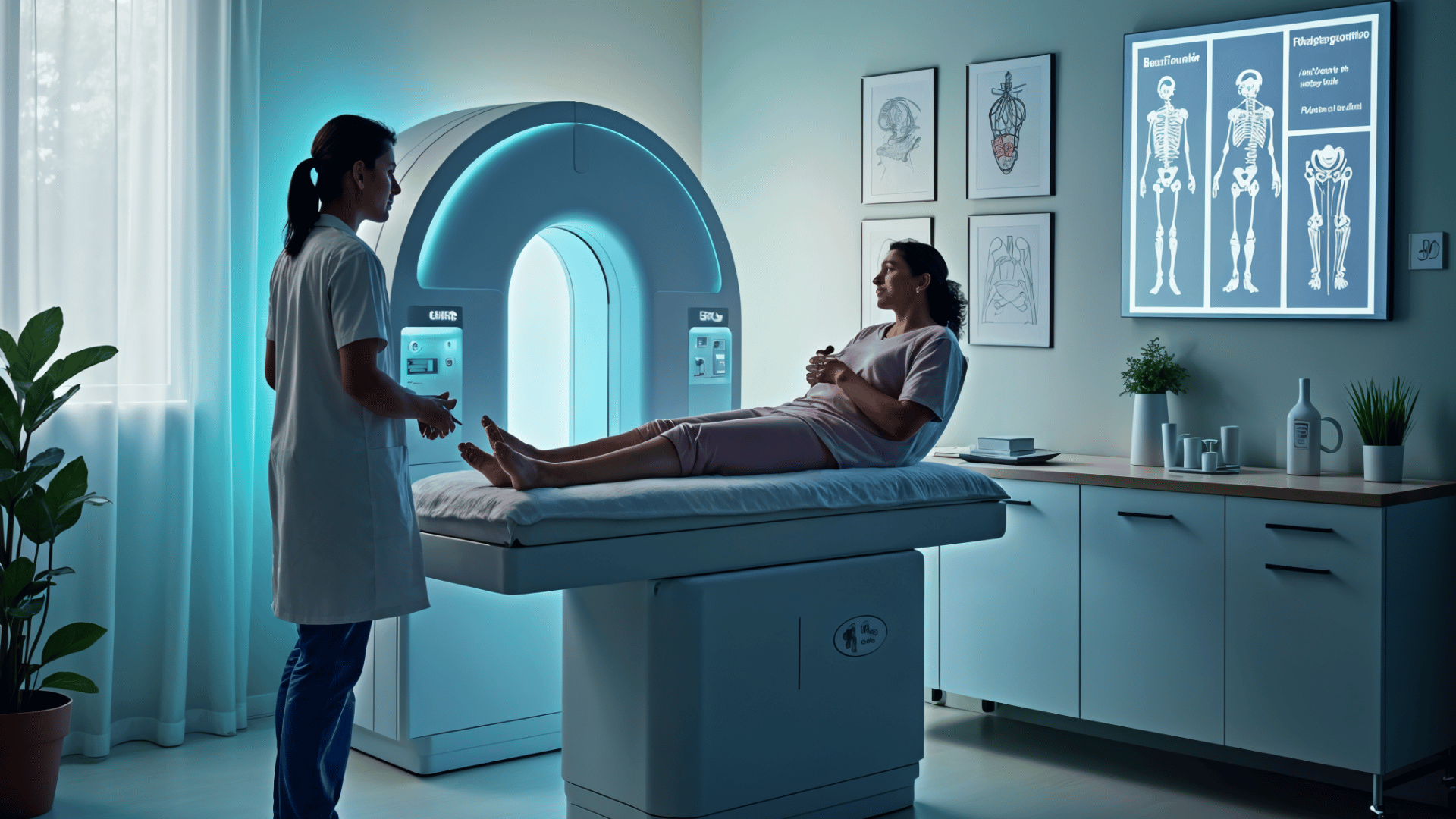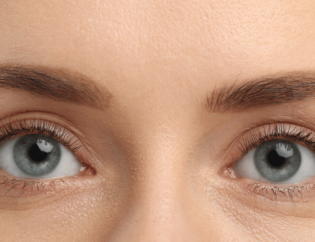
Understanding Bone Density Tests
Bone density tests, especially the DXA scan (Dual-Energy X-ray Absorptiometry), are vital for checking bone health and diagnosing conditions like osteoporosis. This quick and painless imaging test measures the mineral density of bones, mainly in the lumbar spine and hip. It helps assess an individual’s risk of fractures. The procedure usually takes about 10 to 30 minutes and involves minimal radiation, making it a safe choice for those worried about their bone health. According to the Cleveland Clinic, patients lie on a padded table while a scanning arm moves over them, capturing images of the bones. The results are shown as T-scores, which compare the patient’s bone density to that of a healthy young adult. A T-score between 0 and -1 is normal, while scores below -2.5 indicate osteoporosis.
Knowing the cost of bone density tests is important for patients considering this screening. The price of a DXA scan can vary widely, typically ranging from $100 to $300 based on factors like the facility, location, and insurance coverage. Many insurance plans cover the test for those at high risk for osteoporosis, including women over 65 and men over 70, as noted by MedlinePlus. Patients should check with their insurance providers to understand their coverage options and potential out-of-pocket costs before scheduling the test.
Regular screenings are especially important for individuals at higher risk of osteoporosis, such as those with a family history of the disease or certain medical conditions. The National Osteoporosis Foundation recommends that women aged 65 and older and men aged 70 and older undergo bone density testing. Early detection through DXA scans can lead to timely interventions, improving patient outcomes and potentially reversing osteoporosis through targeted therapies and lifestyle changes.
In summary, understanding the costs of bone density tests and the importance of regular screenings can empower individuals to take proactive steps in managing their bone health. For more detailed information on the procedure and its significance, refer to the Journal of Positive Psychology.
Types of Bone Density Tests
Bone density tests are essential for assessing bone health and diagnosing conditions like osteoporosis. The most common type is the DXA scan (Dual-Energy X-ray Absorptiometry), recognized as the gold standard for measuring bone mineral density (BMD). This non-invasive procedure typically takes about 10 to 30 minutes and involves minimal radiation, making it a safe option for patients. During the test, patients lie on a padded table while a scanning arm moves over them, capturing images of the bones, particularly in the lumbar spine and hip areas. The results are expressed as T-scores, which compare the patient’s bone density to that of a healthy young adult. A T-score between 0 and -1 is normal, while scores below -2.5 indicate osteoporosis, a condition characterized by weakened bones and an increased risk of fractures.
The cost of bone density tests can vary significantly, typically ranging from $100 to $300. Factors influencing the price include the testing facility, geographic location, and whether the patient has insurance coverage. Many insurance plans cover the cost of DXA scans for individuals at high risk for osteoporosis, such as women over 65 and men over 70, as well as those with a family history of the disease. Patients are encouraged to check with their insurance providers to understand their coverage options and potential out-of-pocket expenses before scheduling the test. For more detailed information on the costs, refer to the Cleveland Clinic.
Regular screenings are essential for individuals at higher risk of osteoporosis, as early detection can lead to timely interventions and management strategies to prevent fractures. According to the National Osteoporosis Foundation, screening is recommended for all women aged 65 and older and men aged 70 and older. Additionally, younger individuals with risk factors such as a history of fractures or prolonged use of glucocorticoids should also consider getting tested. Understanding the importance of these tests can empower patients to take proactive steps in managing their bone health.
In summary, bone density tests, particularly DXA scans, are vital tools in diagnosing osteoporosis and assessing fracture risk. With costs ranging from $100 to $300, it is essential for patients to be informed about their insurance coverage and the significance of regular screenings. For further reading on the procedure and its implications, visit MedlinePlus and the NCBI.
What to Expect During a Bone Density Test
Bone density tests, especially the DXA scan (Dual-Energy X-ray Absorptiometry), are essential for assessing bone health and diagnosing conditions like osteoporosis. This quick and painless imaging test typically takes about 10 to 30 minutes and involves minimal radiation exposure, making it a safe option for patients. During the procedure, patients lie on a padded table while a scanning arm moves over them, capturing images of the bones. The results are expressed as a T-score, which compares the patient’s bone density to that of a healthy young adult. A T-score between 0 and -1 is considered normal, while scores below -2.5 indicate osteoporosis, a condition characterized by weakened bones and an increased risk of fractures.
Understanding the cost of bone density tests is crucial for patients considering this important screening. The price of a DXA scan can vary significantly, typically ranging from $100 to $300 depending on factors such as the facility, geographic location, and whether the patient has insurance coverage. Many insurance plans cover the cost of the test for individuals at high risk for osteoporosis, including women over 65 and men over 70. Patients are encouraged to check with their insurance providers to understand their coverage options and potential out-of-pocket expenses before scheduling the test. For more information on insurance coverage, visit the Cleveland Clinic.
Regular screenings are particularly important for individuals at higher risk of osteoporosis, such as those with a family history of the disease or certain medical conditions. The National Osteoporosis Foundation recommends that all women aged 65 and older and men aged 70 and older undergo bone density testing. Additionally, younger individuals with risk factors, such as a history of fractures or prolonged use of glucocorticoids, should also consider getting tested.
In summary, a DXA scan is a vital tool for diagnosing osteoporosis and assessing fracture risk. Understanding the procedure, its costs, and the importance of regular screenings can empower patients to take proactive steps in managing their bone health. For further details on the procedure, refer to the Cleveland Clinic’s guide on DXA scans and the MedlinePlus overview of bone density scans.
Cost Breakdown of Bone Density Tests
Bone density tests, particularly the DXA scan, are essential for assessing bone health and diagnosing conditions like osteoporosis. Understanding how much do bone density tests cost is crucial for individuals considering this important screening. The cost of a DXA scan can vary significantly, typically ranging from $100 to $300. This variation is influenced by several factors, including the testing facility, geographic location, and whether the patient has insurance coverage. For instance, tests performed in hospitals may be more expensive than those conducted in outpatient clinics. Patients are encouraged to check with their insurance providers to understand their coverage options and potential out-of-pocket expenses before scheduling the test (Cleveland Clinic).
The DXA scan is a quick, painless procedure that usually takes about 10 to 30 minutes. During the test, patients lie on a padded table while a scanning machine passes over their body, measuring the density of bones in key areas such as the lumbar spine and hip. The results are expressed as T-scores, which compare the patient’s bone density to that of a healthy young adult. A T-score between 0 and -1 is considered normal, while scores below -2.5 indicate osteoporosis (MedlinePlus).
For individuals at higher risk of osteoporosis, such as women over 65 and men over 70, regular screenings are recommended. These tests are crucial for early detection and management of bone health issues, potentially preventing fractures and other complications associated with weakened bones (NCBI).
In summary, the cost of bone density tests can vary widely, but understanding the pricing structure and insurance coverage is essential for making informed decisions about bone health. Regular screenings through DXA scans can lead to timely interventions, improving patient outcomes and potentially reversing osteoporosis through targeted therapies and lifestyle changes (StatPearls). For more information on the importance of these tests, consider visiting the National Osteoporosis Foundation.
Insurance Coverage for Bone Density Tests
Bone density tests, particularly the DXA scan, play a crucial role in assessing bone health and diagnosing conditions like osteoporosis. Understanding how much do bone density tests cost is essential for individuals considering this important screening. The cost of a DXA scan can vary significantly, typically ranging from $100 to $300 depending on several factors, including the facility, geographic location, and whether the patient has insurance coverage. Patients are encouraged to check with their insurance providers to understand their coverage options and potential out-of-pocket expenses before scheduling the test.
A DXA scan, or dual-energy X-ray absorptiometry, is a non-invasive imaging test that measures bone mineral density (BMD) at key sites such as the lumbar spine and hip. This test is particularly recommended for individuals at higher risk of osteoporosis, including women over 65 and men over 70, as well as those with a family history of the disease. Regular screenings can help detect bone density issues early, allowing for timely intervention and management to prevent fractures and other complications associated with weakened bones. According to the Cleveland Clinic, the results of a DXA scan are expressed as a T-score, which compares the patient’s bone density to that of a healthy young adult. A T-score between 0 and -1 is considered normal, while scores below -2.5 indicate osteoporosis.
Preparation for a bone density scan may involve avoiding calcium supplements for 24 to 48 hours prior to the test and wearing non-metal clothing to ensure accurate results. The procedure itself is quick, typically taking about 10 to 30 minutes, and involves minimal radiation exposure, making it a safe option for patients concerned about their bone health. The National Institutes of Health emphasizes the importance of early detection through DXA scans, as they can lead to effective management and treatment of osteoporosis, potentially reversing its effects through lifestyle changes and medication.
In summary, understanding the costs associated with bone density tests is vital for individuals at risk of osteoporosis. By being informed about the cost of DXA scans and the importance of regular screenings, patients can take proactive steps in managing their bone health. For more detailed information on the procedure and its significance, visit MedlinePlus and the Journal of Clinical Densitometry.
Tips for Reducing Bone Density Test Costs
Bone density tests, particularly the DXA scan, are essential for assessing bone health and diagnosing conditions like osteoporosis. However, the costs associated with these tests can be a concern for many patients. Understanding how to reduce these costs can make a significant difference in managing your bone health. Here are some effective tips for reducing bone density test costs while ensuring you receive the necessary care.
1. Check Insurance Coverage
Before scheduling a bone density test, it’s crucial to check with your insurance provider to understand your coverage options. Many insurance plans cover DXA scans for individuals at high risk for osteoporosis, such as women over 65 and men over 70. According to the Cleveland Clinic, the cost of a DXA scan can range from $100 to $300, depending on the facility and insurance coverage. Knowing your benefits can help you avoid unexpected out-of-pocket expenses.
2. Shop Around for Prices
The cost of bone density tests can vary significantly based on location and facility type. It’s advisable to call different clinics and hospitals to compare prices. Some facilities may offer promotional rates or discounts for cash payments. Websites like MedlinePlus emphasize the importance of inquiring about specific pricing before scheduling the test, as this can lead to substantial savings.
3. Consider Community Health Programs
Many community health organizations and non-profits offer bone density testing at reduced rates or even for free. These programs are often aimed at individuals who may not have insurance or who are underinsured. Research local health fairs or community clinics that may provide these services.
4. Discuss Payment Plans with Providers
If you find that the cost of a bone density test is still a barrier, consider discussing payment options with your healthcare provider. Many facilities offer payment plans that allow you to spread the cost over several months, making it more manageable.
5. Utilize Preventive Care Benefits
Some insurance plans include preventive care benefits that cover screenings like bone density tests at no cost to the patient. Check if your plan offers this benefit, as it can significantly reduce your expenses. The National Institutes of Health recommends regular screenings for those at risk, which may be covered under preventive care provisions.
Conclusion
By taking these steps, you can effectively reduce the costs associated with bone density tests while ensuring you receive the necessary care to monitor your bone health. Regular screenings are vital for early detection and management of osteoporosis, which can prevent serious complications in the future. For more information on bone density tests and their importance, visit the Cleveland Clinic or MedlinePlus.
Understanding Your Bone Density Test Results
Understanding your bone density test results is crucial for assessing your bone health and determining your risk for osteoporosis. The most common method for measuring bone density is the DXA scan (Dual-Energy X-ray Absorptiometry), which is a quick and painless procedure that typically takes about 10 to 30 minutes. During the test, you will lie on a padded table while a scanning machine passes over your body, capturing images of your bones. This test is essential for diagnosing conditions like osteopenia and osteoporosis, which can lead to increased fracture risk if left untreated.
The results of a DXA scan are reported as T-scores and Z-scores. The T-score compares your bone density to that of a healthy young adult, while the Z-score compares it to others of the same age and sex. A T-score between 0 and -1 is considered normal, indicating healthy bone density. Scores between -1 and -2.5 suggest osteopenia, a condition where bone density is lower than normal but not low enough to be classified as osteoporosis. A T-score of -2.5 or lower indicates osteoporosis, which significantly increases the risk of fractures. Understanding these scores is vital for determining the appropriate treatment and monitoring your bone health over time. As noted by the Cleveland Clinic, “The closer to zero your T score is, the stronger your bones are.”
The cost of a DXA scan can vary widely, typically ranging from $100 to $300 depending on the facility and whether insurance covers the procedure. It is advisable to check with your insurance provider to understand your coverage options and potential out-of-pocket expenses before scheduling the test. Many insurance plans cover the cost of bone density tests for individuals at high risk for osteoporosis, such as women over 65 and men over 70, as highlighted in the MedlinePlus resource.
Regular screenings are crucial for individuals at higher risk, including those with a family history of osteoporosis or other risk factors. Early detection through DXA scans can lead to timely interventions, improving patient outcomes and potentially reversing osteoporosis through targeted therapies and lifestyle changes. As emphasized in the National Institutes of Health, understanding the importance of bone density testing is vital for preventing fractures in older adults.
In summary, knowing how to interpret your bone density test results and understanding the associated costs can empower you to take proactive steps in managing your bone health. If you have concerns about your bone density or risk factors for osteoporosis, consult your healthcare provider for personalized advice and recommendations.
How Often Should You Get a Bone Density Test?
Bone density tests, particularly the DXA scan, play a crucial role in assessing bone health and diagnosing conditions like osteoporosis. The frequency of these tests largely depends on individual risk factors, including age, gender, and family history of osteoporosis. For instance, the National Osteoporosis Foundation recommends that women aged 65 and older and men aged 70 and older undergo bone density testing at least once every two years. Additionally, younger individuals with risk factors—such as a family history of osteoporosis, low body weight, or prolonged use of glucocorticoids—should also consider getting tested more frequently.
The DXA scan is a quick, painless procedure that typically takes about 10 to 30 minutes. During the test, patients lie on a padded table while a scanning machine passes over their body, measuring the minerals in their bones, primarily calcium. The results are expressed as T-scores, which compare the patient’s bone density to that of a healthy young adult. A T-score between 0 and -1 is considered normal, while scores below -2.5 indicate osteoporosis. Understanding these scores is vital for determining the appropriate treatment and monitoring bone health over time. Regular screenings can help detect bone density issues early, allowing for timely intervention and management to prevent fractures and other complications associated with weakened bones.
The cost of a DXA scan can vary significantly, typically ranging from $100 to $300, depending on the facility and whether insurance covers the procedure. Patients are encouraged to check with their insurance providers to understand coverage options and potential out-of-pocket expenses before scheduling the test. This variability in cost can be a concern for many, especially those at higher risk who may require more frequent testing. Therefore, understanding how much do bone density tests cost is essential for planning and managing healthcare expenses effectively.
In summary, the frequency of bone density tests should be tailored to individual risk factors, with regular screenings recommended for those at higher risk. The DXA scan remains the gold standard for measuring bone mineral density and diagnosing osteoporosis, making it an essential tool in maintaining bone health. For more information on the procedure and its significance, refer to the Cleveland Clinic’s overview of the DXA scan and MedlinePlus’s guide on bone density scans.
Conclusion: Investing in Your Bone Health
Investing in your bone health is crucial, especially as we age. Regular screenings through bone density tests, particularly the DXA scan, play a vital role in assessing bone strength and diagnosing conditions like osteoporosis. Understanding the costs associated with these tests can help you make informed decisions about your health.
A DXA scan, or dual-energy X-ray absorptiometry, is a non-invasive imaging test that measures bone mineral density (BMD). This test is essential for diagnosing osteoporosis, a condition that affects millions of older adults and increases the risk of fractures. The procedure typically takes about 10 to 30 minutes and involves minimal radiation exposure, making it a safe option for patients concerned about their bone health. According to the Cleveland Clinic, the cost of a DXA scan can vary widely, generally ranging from $100 to $300 depending on the facility and whether insurance covers the procedure.
Understanding your T-score, which compares your bone density to that of a healthy young adult, is crucial. A T-score between 0 and -1 is considered normal, while scores below -2.5 indicate osteoporosis. Regular screenings are particularly recommended for individuals at higher risk, such as women over 65 and men over 70, as well as those with a family history of osteoporosis. The National Osteoporosis Foundation emphasizes the importance of early detection through DXA scans to prevent fractures and manage osteoporosis effectively.
In addition to the initial costs, it’s important to consider the long-term benefits of investing in your bone health. Regular monitoring through DXA scans can lead to timely interventions, improving patient outcomes and potentially reversing osteoporosis through targeted therapies and lifestyle changes. As noted in a study published in the Journal of Clinical Densitometry, patients receiving appropriate treatment showed significant improvements in BMD, underscoring the importance of these tests.
Before scheduling a DXA scan, it’s advisable to check with your insurance provider to understand coverage options and potential out-of-pocket expenses. This proactive approach not only helps in managing costs but also ensures that you are taking the necessary steps to maintain your bone health. By investing in regular bone density tests, you are making a commitment to your long-term health and well-being.











